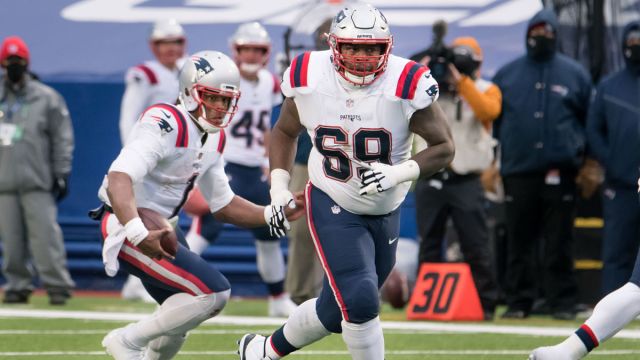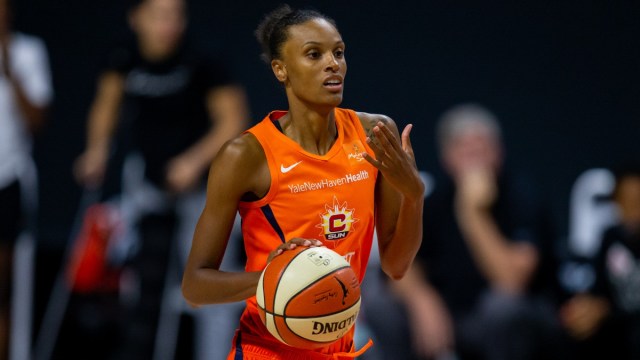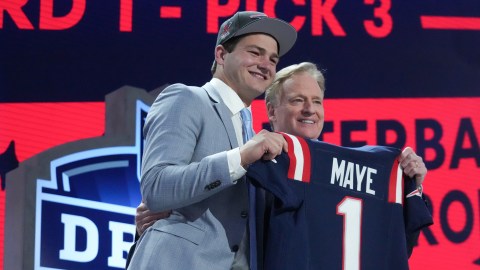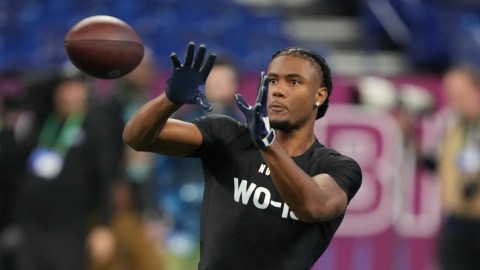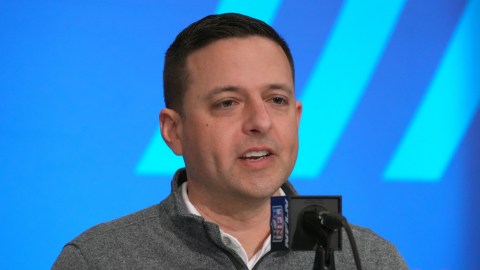On the second-to-last carry of his collegiate career, Rhamondre Stevenson took a shotgun handoff from quarterback Spencer Rattler and brushed past the arm tackle of a blitzing Florida safety.
Moments later, he ran through a linebacker, his white undershirt stretching in the defender’s grasp.
Then he juked left to evade another lunging linebacker, and then right, to get past a second safety and a defensive end. All three players wound up sprawled on the AT&T Stadium turf.
Finally, Stevenson delivered a stiff-arm to the chest of 313-pound tackle Jalen Lee, trotted into the end zone and blew a kiss to the Oklahoma fans in attendance.
That 15-yard touchdown romp headlined the most dominant rushing performance of Stevenson’s two-year Sooners tenure — he finished with 186 yards on 18 carries in a 55-20 Cotton Bowl rout — and showcased the skill set that made him such an intriguing New England Patriots draft pick.
Stevenson (fourth round, 120th overall) boasts a rare blend of size and shiftiness that made him extremely difficult for Big 12 defenders to bring down.
Measuring in at 6 feet, 231 pounds — the heaviest Patriots running back ever drafted under Bill Belichick — Stevenson forced an average of 0.36 missed tackles per carry in 2020, according to Pro Football Focus, the fifth-best mark in the FBS. Only second-round pick Javonte Williams broke tackles at a higher rate while also logging more carries.
Stevenson’s arsenal of evasive maneuvers included jukes:
… spin moves:
… stiff-arms:
… nifty footwork:
… and pure power:
Stevenson used these moves to turn short gains into big ones and minimize negative plays. He rarely was stopped in the backfield and was effective in goal-to-go situations, scoring on four of his six rushing attempts from inside the 6-yard line.
At his pro day, Stevenson tested in the 78th percentile among running backs in the short shuttle while also ranking in the 90th percentile in weight. Arm-tackle him at your own peril.
“I don’t like to lose yards,” Stevenson said in his introductory conference call, “so I just try to fall forward after contact.”
Had Stevenson not been suspended for the first five games last season following a reported positive test for marijuana in 2019 — the same ban that sidelined fellow Patriots draft pick Ronnie Perkins — he might have ranked among college football’s rushing leaders.
He finished with 665 rushing yards and seven touchdowns in six games, averaging 110.8 per contest and 6.6 per carry. Extrapolated over Oklahoma’s full 11-game schedule, that’s 1,219 yards — a mark only four FBS ball-carriers topped in 2020.
Stevenson’s tackle-breaking prowess is only half of his game, though. Notably, the 23-year-old also played a significant role in Oklahoma’s passing attack, both as a receiver and as a blocker. He caught 18 passes for 211 yards in his abbreviated final season — strong numbers for a back his size — and generally held up well in pass protection.
Take a look at this one rep against Baylor. Stevenson blocks a blitzing linebacker into the flat, releases, catches a short pass from Rattler and runs through multiple attempted tackles for a 19-yard gain:
Here’s another example, from Stevenson’s first game back from suspension. On the second play from scrimmage against Oklahoma State, he caught a screen pass behind the line and galloped for 45 yards, breaking multiple tackles in the process:
If Stevenson can replicate that type of pass-game potential early in his pro career, he might be able to avoid the rookie-year pseudo-redshirt that Patriots running backs like Shane Vereen, James White, Damien Harris and J.J. Taylor endured in previous seasons.
White currently is the only proven pass-catching back on New England’s roster, with the early-down duo of Harris and Sony Michel combining for just 12 receptions in 2020. Taylor added one catch for 4 yards as an undrafted rookie. The versatile Rex Burkhead remains a free agent, and even if he eventually re-signs, he likely won’t be healthy to start the year after suffering a season-ending knee injury in November.
Stevenson isn’t a perfect prospect, of course, and some of his flaws are evident in the above clips. With a 4.64-second 40-yard dash that ranked in the 24th percentile for his position, he lacks breakaway speed and won’t outrun many NFL defensive backs. He also tested poorly in metrics that measure burst (7th percentile in the 10-yard split) and explosiveness (16th percentile in vertical jump, 13th in broad jump).
Draft analysts also pointed to Stevenson’s collegiate workload as a potential concern. He basically started just one half-season at the Division I level, seeing sporadic action in 2019 after transferring in from Cerritos Community College (where he averaged a preposterous 191.9 rushing yards per game in 2018). He logged a modest 165 total carries over his two seasons at OU.
Overall, though, Stevenson has the tools to potentially develop into a three-down back at the NFL level.
“I think Stevenson’s best football is in front of him,” Patriots head coach Bill Belichick said on draft day. “He’s big. He can run. He can catch. He’s certainly going to need a lot of work on some of the other finer points. That’s what we’re here for. I’m sure he’ll be ready to get to work and do it.”

